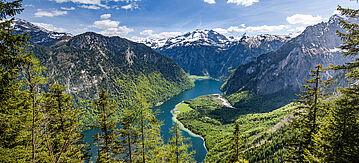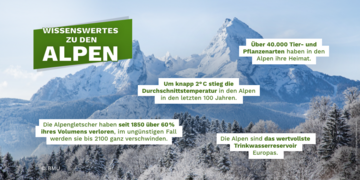Alpine Convention

Protection and sustainable development of the Alps
The first Alpine Conference in Berchtesgaden in 1989, initiated by the Federal Ministry for the Environment, Nature Conservation and Nuclear Safety, identified an urgent need for action to protect the Alps. The participants agreed to draw up a binding convention under international law for the protection of the Alps.

- The Alps are home to over 40,000 species of flora and fauna.
- The average temperature in the Alps has increased by nearly 2°C in the last 100 years.
- Alpine glaciers have lost more than 60 percent of their volume since 1850, and in the worst-case scenario, they will disappear completely by 2100.
- The Alps are the most important source of drinking water in Europe.
The Alpine Convention was signed in 1991 by the Alpine nations of Austria, France, Germany, Italy, Liechtenstein and Switzerland as well as by the European Community at the II Alpine Conference held in Salzburg, Austria. Monaco became a Contracting Party to the Convention on the basis of an additional Protocol. Slovenia signed the Convention on 29 March 1993. The Convention entered into force in 1995. Germany ratified the Convention on the Protection of the Alps (Alpine Convention) of 7 November 1991 by a law of 29 September 1994 (Federal Law Gazette 1994 II, p. 2538).
The Alpine Convention is a framework convention for the protection and sustainable development of the Alpine region. The Contracting Parties undertake to achieve this goal together.
The Alpine Convention calls for a holistic policy approach which is implemented by the Contracting Parties through nine Protocols: spatial planning and sustainable development, nature protection and landscape conservation, mountain farming, mountain forests, tourism, soil conservation, energy, transport, and solution of litigations. The Protocols are independent implementation agreements under international law and have to be ratified individually.
Liechtenstein, Germany, Austria, Slovenia, France and Italy ratified all Protocols between 2002 and 2012, and Monaco and the European Union ratified most between 2003 and 2013. Switzerland has yet not ratified any of the Protocols. In 2010, the Swiss Parliament ultimately decided not to ratify the implementing protocols of the Alpine Convention.
Article 2 of the Alpine Convention envisages further measures in the sectors population and culture, prevention of air pollution and water and waste management. One of the reasons the Alpine Conference has not decided whether to draw up further Protocols is that not all Contracting Parties to the Convention have ratified all existing Protocols to date. In 2006, however, the IX Alpine Conference adopted a political declaration on population and culture. In addition, the XIV Alpine Conference issued a declaration to strengthen the sustainable economy of the Alps on 13 October 2016.
The VII Alpine Conference decided on the location of the Permanent Secretariat of the Alpine Convention in 2002. Since 2003, the Permanent Secretariat has been based in Innsbruck, Austria, with a branch office in Bozen, Italy. Alenka Smerkolj (Slovenia) currently holds the office of Secretary General.
The Multi-Annual Work Programme (MAP) is a tool for ensuring that the Alpine Convention and its Protocols are proactively implemented over the long term. The MAP also sets joint priorities for the activities of the Alpine States. The XIV Alpine Conference (2016) adopted the new Multi-Annual Work Programme 2017-2022. The joint work will focus on six cross-sectoral areas until 2022.
People and culture, taking action on climate change, conserving and valuing biodiversity and the landscape, greening the economy, promoting sustainable transport and playing a leading role in the macroregional strategy for the Alpine region (EUSALP).
Reports on the State of the Alps have been drawn up on the most important developments in the Alpine region. The topics covered by the reports are determined by the Alpine Conference. Eight Reports on the State of the Alps have been published to date:
- Transport and Mobility (2007)
- Water and Water Management Issues (2009)
- Sustainable Rural Development and Innovation (2011)
- Sustainable Tourism in the Alps (2013)
- Demographic changes in the Alps (2015)
- Greening the Economy in the Alpine Region (2016)
- Natural Hazard Risk Governance (2019)
- Air Quality (2020)
The XVI Alpine Conference decided that the 9th Report on the State of the Alps will focus on Alpine towns. The Reports on the State of the Alps are usually published in the Alpine Signals series of the Alpine Convention.
Some current environmental topics – such as climate change – are not directly addressed by the Protocols of the Alpine Convention. The ministers have acknowledged this issue, which is particularly relevant for the Alpine region, with political declarations (Alpine Conference 2006, 2019) as well as the Climate Action Plans (Alpine Conference 2009, 2020). The Alpine Climate Board, one of the thematic working groups of the Alpine Convention, also set up its own website in 2020.
The Alpine Conference Presidency rotates on a biannual basis. Germany held the Presidency for the 2015-2016 period and Austria 2017-2018. France handed over the Presidency to Switzerland at the XVI Alpine Conference on 10 December 2020. It will be Slovenia’s turn in 2023.
